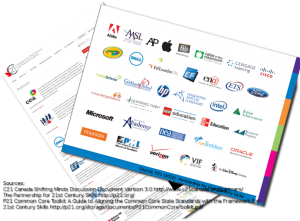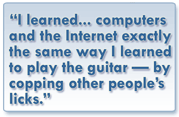Educators can be leaders in Education Reform, but one sector, whom no one denies is a needed stakeholder, just wants to throw money at the problems—and at defining the problems and overwhelming the Public’s perception of problems. They venture to extract even more money by solving the problems, and to that end they’ve invested in a system of collecting numbers that “prove” the problems persist. skewing the outcome towards a single perspective. As the array of multinational conglomerate logos in the images show this is part of the landscape across the world, in North America in general, but it’s especially true in the United States, where the textbook, testing, school supplies industries are entrenching a new status quo. 
A retiring principal in New York state recently said,
Apple! McDonald’s! Microsoft! Starbucks! Google! None of these endeavors or companies were started by excellent test-takers! I fear that our present cadre of educational reformers – the non-educators noted above – are creating children who are great little test-takers, who can select A, B, C or D as an answer with the best of them, and whose performance can be placed onto a nice little spreadsheet. But we must ask ourselves, at what price?”
(Don Sternberg, 2013,
quoted on Diane Ravitch’s blog)
But there’s a flaw in Dr. Sternberg’s statement as written: educational reformers do not create children, are not in classrooms, and won’t be the ones hired to create engaging alternatives to classrooms, or powerful digital enhancements to classroom instruction, or plan how to use all those things effectively in authentic projects then do so. Parents create children. Educators educate them. I argue these two groups have the most invested, both in tax dollars and in interest in the outcome, and therefor must remain strong allies. Corporate strategists must also believe this, as some go to great lengths to divide parents and teachers, and conquer each group separately.
The only counter to this is a truism: The Private needs The Public in order to survive.
Such an assertion requires evidence, and educationists are the ones to provide it. (Rodríguez-Romero, 2008)
The education sector can find its own cohesion by encouraging and promoting use of Public Buildings. The president’s jobs plan includes rebuilding schools. Be active, and support activists in your community by making noise, let everyone know you want to build and rebuild schools in your area. Build them as optimized Public Spaces, usable 24/7 if your neighborhood can benefit from that, at cost-recovery prices or less, during hours that attract the most people in your locality. Invest in putting Kids, Students, Parents, Communities—all the local experts—first.
We can tell it’s the right way to look at it because the people who use the system most, all those I just named are 1) both main users & main investors in system (taxes) 2) the experts on how and what works and what is needed first 3) the ones whose daily lives and futures are affected by the decisions being made.
We all stand to profit from a Student/Parent/Community-centric approach. Local Business knows dollar profits mean nothing when Talent goes undeveloped, withers, becomes easily undercut from outside, is forced to move away. We all can understand that not all value and profit is in dollars and cents. Democracy thrives in knowledge—nurtured by scholars, and sense.
Teachers need to stay focused on good pedagogy, but even those many great teachers who are still too busy to Tweet and blog now need to add some level of social networking and DIY technology. It’s not just about time spent teaching, but more practical, as communication with Parents and Community. A teacher who collaborates with the school and community to expose the exciting learning situations that are happening, make the thinking behind them transparent and visible, see the Learners and their Learning recognized, applauded and celebrated, is the best advocate for public education anyone could hope for. A parent who is a programmer, mechanic, shop-owner, assembly-line worker, a lawyer or any local business that does Something Kids Find Engaging—a potential career path, hobby, or even passing fad—all of these are valid 21st century situations where learning is already taking place. How do we tap in, without skipping a beat or losing stride?
DIY tech, like your class blog or web page, projects you share in real time on the Internet, all these are ways to bring people into your classroom, into your building and into a growing sense of sharing a common purpose. Just do it. We’ve talked for 40 years about “situated” learning. It’s time we start thinking about learning situations and the situations where learning happens—and then create them and share them Publicly.
Kids and Parents can once again come to think of the School as a place that’s good to go evenings and weekends, to meet friends, be in clubs… again, there are too many places where total renovation is required first So be it those are real jobs that people could count on and real investments that benefit ourselves and future generations.
I believe we have to rely even more on our own agency. Don’t just cultivate a personal learning network (PLN), try to join and grow a Community of Practice (CoP). It’s a subtle difference in the role of give and take, a slightly different take on the value of ideas that may be at the periphery of your main interests, but I think a meaningful one. It’s especially meaningful in
Be the best teacher you can be but don’t do it alone. From the ground up, advocate for technology and uses of technology that bring more energetic, engaged and engaging people into your situation. Class trips and parent visits are two-way now, either can be virtual or physical, and your classes’ videoed presentations can be viewed from the business meeting in Ottawa or when mom gets home tomorrow morning after night shift.
When parents view themselves as a collective group and their families as a community bounded by similar interests and desires, a foundation to act collectively and to become more powerful agents in the school emerges. Relationships are at the core of bringing this power to parents.
Warren et al., 2009
[Can the same not be said of any stakeholder group in education? And isn’t the thing about corporate reformers that irks us not so much their money but the way in which many of them have gone about spending it, siphoning and harvesting, rather than planting and growing? –RF]
Then, corporate reformers and venture capitalists will be forced to compete with the kind of value we’ve Pulled From Within Ourselves. It forces them to spend their money on the things the true leaders have demonstrated work, are working, and that get People Where We Are Going . History shows—Public spirit shall overcome.
§
Footnote
Reference and further reading
Rodríguez-Romero, M. (2008), “Situated Pedagogies, Curricular Justice and Democratic Teaching”, in OECD, Innovating to Learn, Learning to Innovate, pp. 113–136, OECD Publishing.
Rittel, Horst W. J. and Webber, Melvin M. (1973), Dilemmas in a General Theory of Planning, Policy Sciences 4 (1973), 155-169. [PDF]
Don Sternberg, Ed.D. Principal, February 26, 2013, letter to parents http://dianeravitch.net/2013/03/11/retiring-principal-stop-the-madness/
Mark R. Warren, Soo Hong, Carolyn Leung Rubin, Phitsamay Sychitkokhong Uy (2009), Beyond the Bake Sale: A Community- Based Relational Approach to Parent Engagement in Schools, Teachers College Record, Volume 111, Number 9, September 2009, pp. 2209–2254, http://bit.ly/nYwbjK (PDF), Accessed March 17, 2013.
 Choosing the right technology for the job depends on many factors. One important factor is fun, and I do have fun making a beautiful print-like chart in Tux guitar. LilyPond offers even more versatility, and now there’s My VexFlow. But some very close friends have asked me to record a Tom Cochrane song on solo acoustic, so I thought I’d share the technology I chose and the criteria by which I chose it.
Choosing the right technology for the job depends on many factors. One important factor is fun, and I do have fun making a beautiful print-like chart in Tux guitar. LilyPond offers even more versatility, and now there’s My VexFlow. But some very close friends have asked me to record a Tom Cochrane song on solo acoustic, so I thought I’d share the technology I chose and the criteria by which I chose it.



